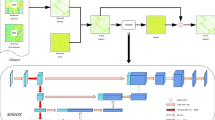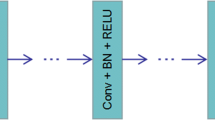Abstract
Low-frequency band-shaped swell noise with strong amplitude is common in marine seismic data. The conventional high-pass filtering algorithm widely used to suppress swell noise often results in serious damage of effective information. This paper introduces the residual learning strategy of denoising convolutional neural network (DnCNN) into a U-shaped convolutional neural network (U-Net) to develop a new U-Net with more generalization, which can eliminate low-frequency swell noise with high precision. The results of both model date tests and real data processing show that the new U-Net is capable of efficient learning and high-precision noise removal, and can avoid the overfitting problem which is very common in conventional neural network methods. This new U-Net can also be generalized to some extent and can effectively preserve low-frequency effective information. Compared with the conventional high-pass filtering method commonly used in the industry, the new U-Net can eliminate low-frequency swell noise with higher precision while effectively preserving low-frequency effective information, which is of great significance for subsequent processing such as amplitude-preserving imaging and full waveform inversion.
Similar content being viewed by others
References
Bekara, M., 2014, Toward an Automatic Swell Noise Attenuation Process: 76th EAGE Conference and Exhibition.
Cai, Y., Shyu, M., Tu, Y. X., Teng, Y., T., and Hu, X., X., 2019, Anomaly detection of earthquake precursor data using long shortterm memory networks: Applied Geophysics, 16(3), 257–268.
Chen, J., 2009, Study on seismic data prestack noise attenuation techniques in deep water: Offshore Oil, 28(2), 29–35.
Das, V., Pollack, A., and Wollner, U., 2018, Convolutional Neural Network for Seismic Impedance Inversion: 88th Ann. Soc. Expl. Geophys. Mtg., Expanded Abstracts, 2071–2075.
Gao, H., 2018, Study of seismic data residual statics and AI denoising: PhD thesis, University of Science and Technology of China, Hefei.
Gou, F., Liu, C., Liu, Y., Wang, B., and Feng, X., 2015, Swell noise attenuations methods based on OC-Seislet transform: Journal of Jilin University, Earth Science Edition, 45(3), 962–970.
Grossmann, A., and Morlet, J., 1984, Decomposition of Hardy Function into Square Integrabble Wavelets of Constant Shape: Society for Industrial and Applied Mathematics, 15(4), 723–736.
Hassan, H., 2005, Empirical mode decomposition (EMD) of potential field data: airborne gravity data as an example: 75th Ann. Soc. Expl. Geophys. Mtg., Expanded Abstracts, 704–706.
He, K. M., Zhang, X., Ren, S., and Sun, J., 2016, Deep residual learning for image recognition: IEEE conference on Computer Vision and Pattern Recognition, 1, 770–778.
Hinton, G. E., and Salakhutdinov, R. R., 2006, Reducing the Dimensionality of Data with Neural Networks: Science, 313(5786), 504–507.
Hu, C. H., and Lu, W. K., 2014, A hybrid method for strong low-frequency noise suppression in prestack seismic data: Journal of Applied Geophysics, 108(9), 78–89.
Huang, N. E., Shen, Z., Long, S. R., et al., 1998, The empirical mode decomposition and the Hilbert spectrum for nonlinear and nonstationary time series analisis: Proceedings of the Royal Society, A(454), 903–995.
Ioffe, S., and Szegedy, C., 2015, Batch normalization: Accelerating deep network training by reducing internal covariate shift: arXiv Preprint, arXiv: 1502.03167.
Liu, J. N., 2018, Automatic pickup of seismic initial arrival waves based on full convolutional neural network: Master’s thesis, University of Science and Technology of China, Hefei.
Liu, Q., Cao, S., and Guan, S., 2013, Seismic data denoising based on wavelet sparsity: 2013CGS, 610.
Lu, X., Huang, H, Li, S., and Yin, L., 2019, Salt-body Classification Method based on U-Net: Chinese Journal of Computational Physics, 1–9.
Ma, J., 2018, Deep learning for attenuating random and coherence noise simultaneously: 80th EAGE Conference and Exhibition.
Mandelli, S., Borra, F., Lipari, V., and Bestagini, P., 2018, Seismic data interpolation through convolutional autoencoder: 88th Ann. Soc. Expl. Geophys. Mtg., Expanded Abstracts, 2018, 4101–4105.
Mou, Y. G., Chen, X. H., Li, G. F., Liu, Y., Wang, S. D., 2007, Seismic data processing methods, Petroleum Industry Press, Beijing.
Nair, V., and Hinton, G. E., 2010, Rectified linear units improve restricted Boltzmann machines: Proceedings of the 27th International Conference on Machine Learning (ICML-10), 807–814.
Ronneberger, O., Fischer, P., Brox, T., 2015, Invited talk: U-Net convolutional networks for biomedical image segmentation: International Conference on Medical Image Computing and Computer Assisted Intervention, Cham, Springer, 234–241.
Stephen, A., 2018, Generative Adversarial Networks in Seismic Data Processing: 88th Ann. Soc. Expl. Geophys. Mtg., Expanded Abstracts, 1991–1995.
Tsai, K. C., Hu, W. Y., and Wu, X. Q., 2018, First-Break Automatic Picking with Deep Semisupervised Learning Neural Network: 88th Annual International Meeting, SEG, Expanded Abstracts 2018, 2181–2185.
Wang, B., Zhang, N., and Lu, W., 2018, Deep Learning Based Seismic Data Interpolation: A Prelimirary Result: Geophysics, 81(1), 11–20.
Zhang, K., Zuo, W., Chen, Y., Meng, D., and Zhang, L., 2017, Beyond a gaussian denoiser: Residual learning of deep cnn for image denoising: IEEE Transactions on Image Processing, 26(7), 3142–3155.
Zhao, M., Chen, S., Fang, L., and David, A., 2019, Earthquake phase arrival auto-picking based on U-shaped convolutional neural network: Chinese Journal of Geophysics (in Chinese), 62(8), 3034–3042.
Acknowledgments
Profound gratitude should go to the Earth Exploration Software Technology R&D Team of Ocean University of China for the funds and hardware and software support, as well as the constructive discussions and opinions provided by the team members. At the same time, I would like to thank the distinguished reviewers for their valuable comments.
Author information
Authors and Affiliations
Corresponding author
Additional information
This work was supported by the Key R&D project of Shandong Province (No. 2019JZZY010803), Fundamental Research Funds for the Central Universities (No. 201964016), the National Natural Science Foundation of China (No. 41704114), the National Science and Technology Major Project of China (No. 2016ZX05027-002), Taishan Scholar Project Funding (No. tspd20161007) and the China Scholarship Council (No. 201906335010).
Zhang Rui-qi graduated from Xi’an Shiyou University with a bachelor’s degree in Marine Oil and Gas Engineering in 2017. He was a master’s student in the School of Marine Geosciences, Ocean University of China, and mainly engaged in artificial intelligence-based seismic data noise attenuation research and its application.
Rights and permissions
About this article
Cite this article
Zhang, Rq., Song, P., Liu, Bh. et al. Low-frequency swell noise suppression based on U-Net. Appl. Geophys. 17, 419–431 (2020). https://doi.org/10.1007/s11770-020-0825-7
Received:
Revised:
Published:
Issue Date:
DOI: https://doi.org/10.1007/s11770-020-0825-7




